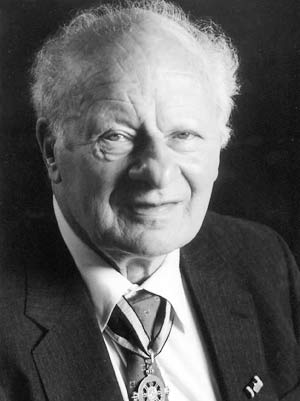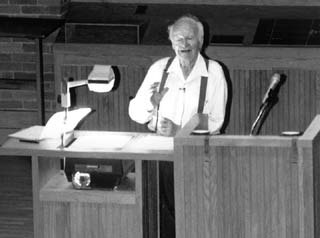Hans Bethe: The one who discovered the sun's secret
Just over a year ago, he was one of the great theoretical physicists of our time, who in the 30s of the last century had found nuclear reaction cycles, discovered the Huge energy source of stars.
With the merits of calculating and explaining the Lamb shift, he is considered by many to be the father of quantum field theory. His life also has many paradoxes. This skinny man had a sickly but funny smile as the head of the Institute of Theoretical Physics in Los Alamos during the US deployment of the wartime Manhattan program.
Had been an important figure in the creation of the first atomic bombs, but after the war, Bethe became a brilliant orator, struggling to oppose nuclear weapons during the negotiation period. in Geneva to go to the east-west peace treaty, disarmament.

Hans Bethe (1906 - 2005) - (Image: aapt.org)
Born on July 2, 1906 in Strasburg, the son of a university lecturer, Bethe studied in Munich and Frankfurt and later also became a lecturer in Munich and Tubingen in the years 1930-1933. Although Bethe's mother was Jewish, he avoided the persecution and discrimination of the Nazis. Receiving a scholarship from the Rockefeller Foundation, Bethe and his friend Rudolf Peierls traveled to Rome and Cambridge to flee Hitler's oppressive Germany. In England, Bethe became a lecturer at the University of Manchester for a year, shared a rented house with the Peierls and traveled six miles to school on an old bike every day. Later, he also found a similar position at the University of Bristol.
At that time, in astrophysics, there was still an unsolved problem. This problem, which was raised by Arthur Eddington in the 1920s, challenges the physical world. That's how stars can continually emit enormous energies over billions of years without being turned off? It used to be thought that energy could be the kinetic energy generated when matter collapses under the influence of a large gravitational field. But calculations have shown that such energy is only sufficient for a star like the Sun for a few million years. Such a huge source of energy for stars is still a mystery.
In 1935, Bethe moved Bristol to Cornell University (USA), and he found the answer hidden in the complexes of highly productive nuclear processes. Bethe thoroughly studied everything that was known back then about atomic nuclei. He wrote a series of three papers on nuclear physics. These articles soon became famous and classics, also known as the "Bethe Bible."
He pointed out that there must be two processes here: at extremely high temperatures, carbon can act as a nuclear catalyst, promoting a process of fusing hydrogen atoms into helium. and generates huge energy due to the lack of mass. This Bethe-initiated carbon cycle, published in 1938, explains the age of extremely hot stars. Bethe also pointed out that, at lower temperatures, under pressure and density similar to that of the Sun, a sequence of developments could lead to a direct combination of hydrogen atoms to form helium and dissolve. releases a lot of energy. This mechanism is close to the working principle of H bombs (now people are still seeking to control this type of fusion reaction to serve energy needs). With fusion reactions, stars' lifetime could reach billions of years, and Bethe's solution was practically verified.
In September 1939, Hitler's army attacked Poland, triggering World War II. Many talented physicists have fled to America. Bethe was then invited to serve as an advisor to the US Defense Research Council. He also works as a researcher at the Radiation Laboratory at the Massachusetts Institute of Technology.
Bethe's most notable activity in the early 1940s was participating in the summer research program in Berkeley in 1942. J. Robert Oppenheimer established a research group on the feasibility of a primary weapon. death. In addition to Bethe, the team includes many other talented physicists such as Edward Teller, Felix Bloch and Emil Konopinski. They have established a theoretical basis for making atomic bombs. In the winter of 1942, the United States began to deploy the "Medicine Program" in Los Alamos under the command of General Leslie R. Groves and Oppenheimer. Teller tried to persuade Bethe to join the program. At first Bethe was hesitant, but at last he accepted. Oppenheimer made him head of the theoretical institute, a position that Teller had longed for. It was this that caused Teller's envy toward Bethe for decades.

Physicist Hans Bethe is awarded the Nobel Prize for his discovery of the energy source of fish
After the war, Bethe returned to Cornell and became an enthusiastic participant in community movements. He propagated more about controlling nuclear power for civilian purposes, he also wrote articles and talked about the dangers of nuclear war. Bethe also continued to pursue her basic scientific research career. In 1947, he published a theoretical calculation of the Lamb shift, explaining the shifting energy levels of electrons in hydrogen atoms. This work by Bethe initiated the field of quantum electrodynamics, which was the first and very classic calculation of quantum field theory.
In 1949, the Soviet Union successfully tested the atomic bomb. The United States is aggressively promoting the hydrogen bomb program (H bomb). Teller once again tried to persuade Bethe to participate in the project of creating this extremely dangerous weapon. At first, Bethe firmly refused, he strongly opposed building weapons of destruction, he also sought to argue that H bombs could not be successfully produced. However, when the Korean War broke out, Bethe agreed to participate in the project, he explained: "... my main desire is to explicitly prove that H bombs will not work." In fact, Teller's original design was proven impossible. However, in early 1951, Teller and Stan Ulam devised a method to detonate H bombs. Then Bethe was also bewildered: "I was convinced that the terrible weapon could become. reality, and we are concerned that Russians can and will make it. " The first H bomb was detonated on October 1, 1952.
In the 1950s, Bethe was a member of the Eisenhower President's Scientific Advisory Council. One of Eisenhower's biggest goals at the time was a pact with the Soviets about banning nuclear weapons testing, and he had faith in Bethe. Even after Eisenhower ended his tenure, Bethe continued to strive for this goal in the early 1960s. Finally, in 1963, President Kennedy signed a treaty banning nuclear weapons testing. in the atmosphere. With her deep knowledge and persuasive ability, Bethe and her tireless contribution to the nuclear weapons disarmament agreements and counterparts.
In 1967, Hans Bethe was awarded the Nobel Prize for his discovery of the energy of stars. In his acceptance speech, Bethe admitted that he was surprised to see many people who made longer, more basic and complex contributions that were not awarded while his work was only done within a short time but still selected to award. It may be Bethe's very honest humility, but we all know that he deserves that Nobel Prize. Because the answer to the energy of stars has become one of the most important applications of physics in our time. Moreover, it has also brought about revolutionary changes in our understanding of the universe.
In addition to the Nobel Prize, Bethe also received many other prestigious awards such as the Max Planck Medal, the Enrico Fermi Award, and the Los Alamos National Laboratory Medal. In 1992, he and Joseph Rotblat were awarded the Albert Einstein Peace Prize.
Bethe retired in 1975, but was still an honorary professor at Cornell. He was active in campaigns demanding the reduction and elimination of weapons of destruction. In an open letter to the scientific community in July 1995, he wrote: "I urgently urge all scientists in all countries to stop and abandon research and development programs. create and develop nuclear weapons, chemical weapons, biological, as well as any other weapons of destruction. " In 1999, at the age of 93, Bethe was still trying to fight against the US Congress's decision to withdraw from the Comprehensive Nuclear Test Comprehensive Treaty.
Hans Bethe died on March 6, 2005. Until his last breath, he continued to pursue his decades-long campaign, one that made the world a safer place for everyone.
FIDITOUR TRAVEL COMMUNICATION COMPANY
Representative: Mr. Tran Van Long - Chairman and General Director
Head office: 95B-97-99 Tran Hung Dao, District 1, City. Ho Chi Minh.
Hanoi Branch: 66 Tran Hung Dao, Hoan Kiem District, Hanoi
Phone: 028 730 56789 | Hotline: 19001177